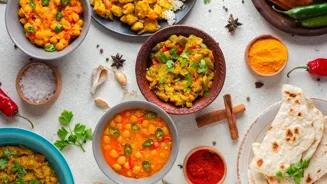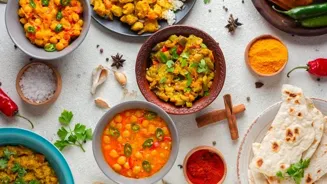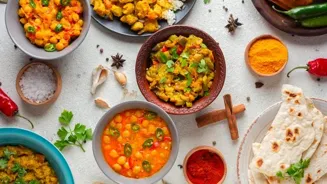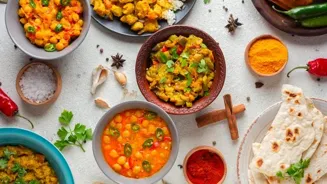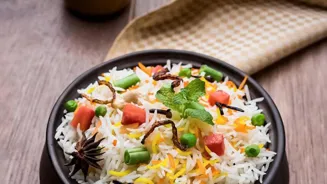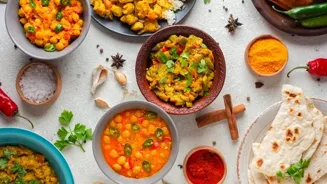Discover the art of making authentic Indian curry at home with just 5 key ingredients. Read more to elevate your cooking game!
Making proper Indian curry at home can seem a bit daunting, innit? You see all
those fancy spices and long ingredient lists, and you think, "Arre baba, too much work!
" But trust me, even if you're a complete novice in the kitchen, you can create a truly delicious and authentic Indian curry with just a few key ingredients. Forget the complicated recipes for now; let's focus on building a solid foundation of flavour with these five must-haves:
Essential Indian curry base: onions, tomatoes, ginger, garlic—bhuno for flavor
First up, you absolutely need a good base of onions, tomatoes, ginger, and garlic. This holy quartet is the foundation of almost every Indian curry, from simple dals to rich paneer dishes. The onions are slowly browned to create a sweet, caramelised flavour that forms the backbone of the curry.
Tomatoes add acidity and sweetness, balancing out the richness of the other ingredients. Ginger and garlic provide a pungent, aromatic kick that awakens the senses. Don't skimp on these – they're what sets Indian curry apart from other cuisines.
Seriously, learn how to properly bhuno, or sauté, this base, and half your battle is already won! A well-bhunoed base is the key to unlocking the potential of all other ingredients. Remember to cook these spices in medium heat, patience is the key in cooking a good base for the curry.
Essential spices for flavor: turmeric, red chili, coriander, cumin
Secondly, your spice cabinet needs to have the very essentials. We're talking about turmeric powder, red chilli powder (like Kashmiri chilli for colour and mild heat), coriander powder, and cumin powder. Turmeric adds a beautiful golden hue and is known for its anti-inflammatory properties.
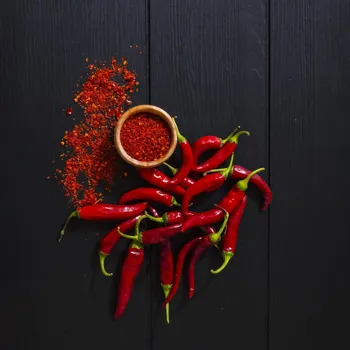
Red chilli powder adds the necessary heat, but be careful not to overdo it! Coriander powder provides a citrusy, earthy note, while cumin powder adds a warm, smoky flavour. These four spices are the building blocks of flavour, the essential colours on your culinary palette.
Once you get comfortable with these, you can start experimenting with other spices like garam masala, amchur (dried mango powder), or kasuri methi (dried fenugreek leaves) – but for now, focus on mastering the basics. Always store your spices in air tight containers.
Fat is essential in curry for flavor and spice release
Third, a good fat is essential for any good curry, and in Indian cooking, that usually means ghee or oil. Ghee, or clarified butter, adds a rich, nutty flavour that elevates the curry to another level.

If you don't have ghee, you can use any neutral cooking oil, but ghee will give a much better taste. The fat is used to sauté the onions and spices, it helps release their flavours.
Don’t be scared to use enough; a generous dose of fat ensures that the spices bloom properly and the curry doesn't stick to the bottom of the pot. A good fat will help bringing out the flavours from other ingredients. Always add the fat in the beginning of the cooking.
Coriander leaves add freshness and flavor to dishes
Fourth, it’s hard to ignore the importance of fresh coriander leaves. Just like ginger and garlic, it can provide an aromatic kick to the final curry. It is often added after the main ingredient is cooked, allowing you to serve the main ingredient which looks and smell fresh.

The coriander provides a vibrant green colour to the food, making the food more appeasing to the consumer. A lot of cooks add fresh coriander leaves prior to serving, so the leaves remain fresh for a longer time.
It is also a great way to test if the food contains the right level of savoury taste without having to taste the main ingredients. The consumer can add the coriander leaves according to their need without wasting extra leaves.
Lentils and chickpeas are key to tasty and nutritious Indian cuisine, offering versatile cooking options
Fifth and finally, do not underestimate the importance of lentils and chickpeas! They are the backbone of vegetarian Indian cuisine, forming the base of countless dals and curries.

From hearty masoor dal to creamy chana masala, these legumes are packed with protein and fibre, making them a healthy and satisfying meal. They can be cooked whole or ground into flour, adding texture and flavour to dishes.
Learn how to properly soak, cook, and temper different types of lentils and chickpeas, and you'll open up a whole new world of culinary possibilities. Consider starting with a simple toor dal tadka, is a delightful dish that will definitely make you crave more.
Remember to boil the beans until tender for the best results.
